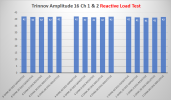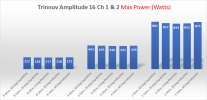No because they understand that the entire case is made out of solid chunk of machined aluminum and in use doesn't get very warm let alone hot. As I explained, the thick case has a very low thermal impedance which works nicely to dissipate the heat all around the case, including the top. The difference in vertical vs horizontal is negligible in this case. You are confusing this situation with other designs where the only thermal relief is the heatsink.
In my testing with reactive load where the amp was repeatedly pushed to clipping, it barely got warm. This is why I didn't take a thermal image of it.
How long did the reactive load test actually last? -How long does it keep it at load? -How long are the pauses in-between?
Earlier, you mentioned that the amplifier warmed up, lost some power, and then regained it once it had cooled down.
"
The above test pushes the amplifier into clipping repeatedly to find the 1% point and it seemed to rob the amplifier of some power. Later reactive tests with the amplifier being cooler showed the full power rating coming back."
How doggedly some people question the horizontal cooling fins here, after it is quite clear that this design more than fulfills its purpose, takes on tragicomic traits. It works perfectly, the box stays just warm even under high load. Rather lukewarm. How cold should it be? Until we have to go through condensation as the next big catastrophe?
The practical reality is that unless the amplifier is run long enough for its thermal mass to fully saturate, we can't determine whether the orientation of the fins has any meaningful impact.
Amir’s tests likely don’t run long enough to saturate the aluminum heat sinks. Yet, as he observed, the amplifier appears to reduce power output, only to recover once it has cooled down from a "
fairly warm" state.
This strongly suggests that the tests aren’t sufficient to evaluate the amplifier’s thermal design -at least not in this case.
A proper approach would be to conduct a "
soak" test, allowing the metal components to reach full saturation before performing power-related measurements.
Additionally, this behavior indicates the presence of a thermal protection circuit, which is generally a good feature. However, the fact that it seems to activate before full saturation, and before the unit gets significantly hot, suggests that certain internal components may be heating up more rapidly than the heat sink can dissipate. -Hot-spots.



